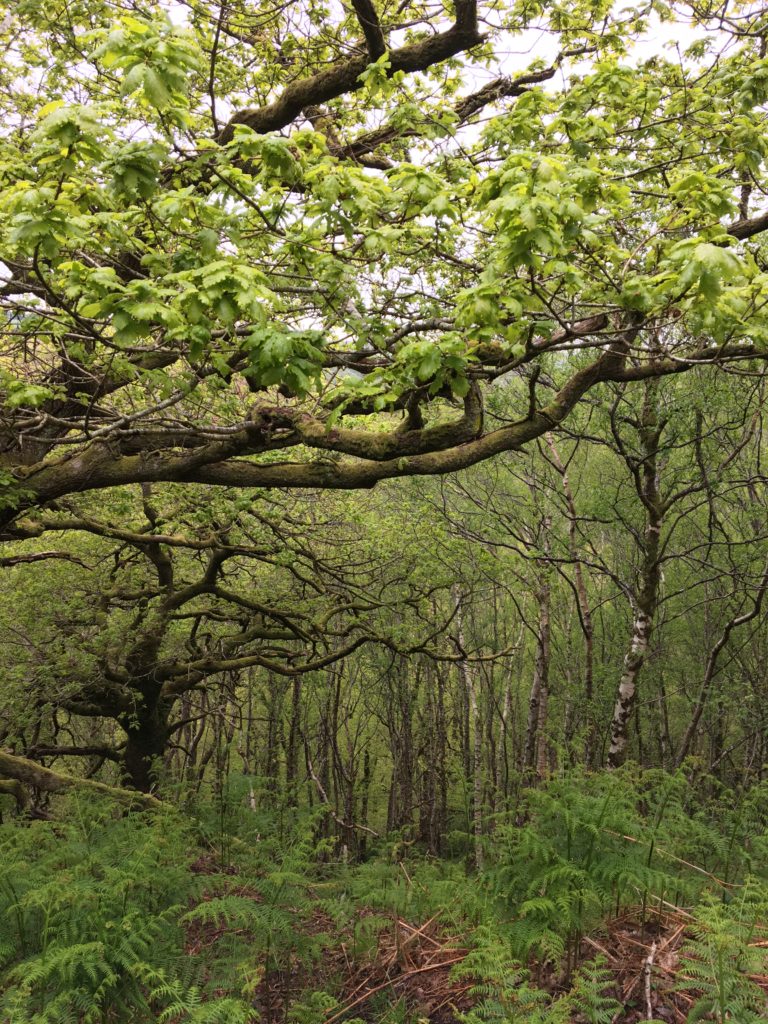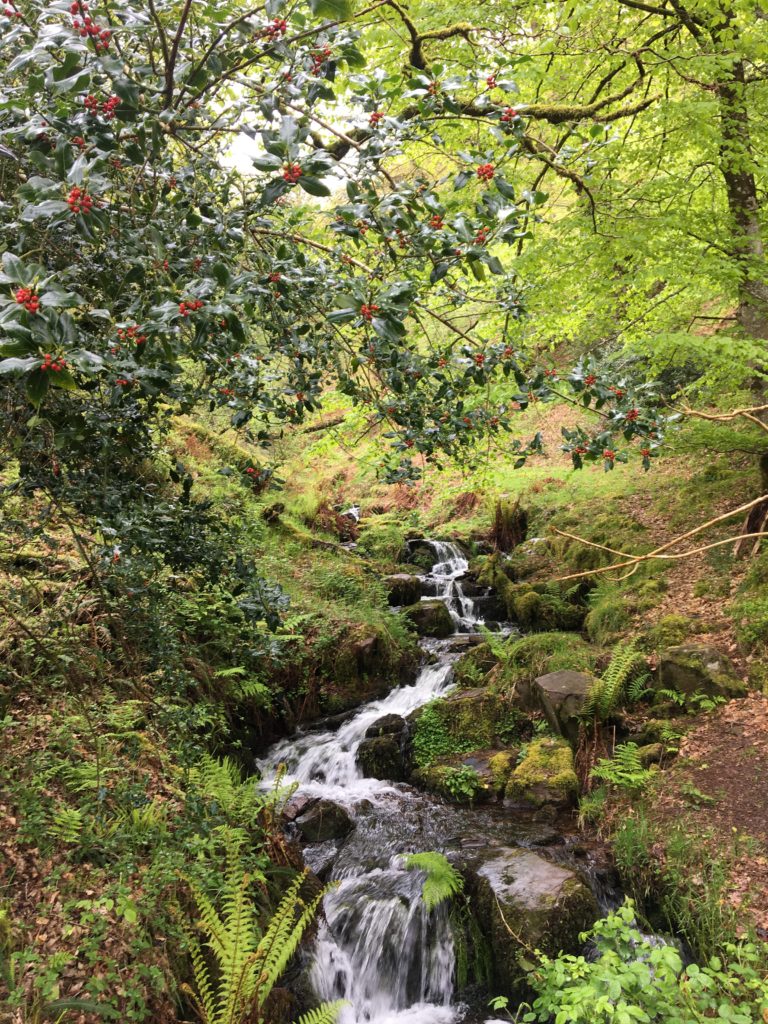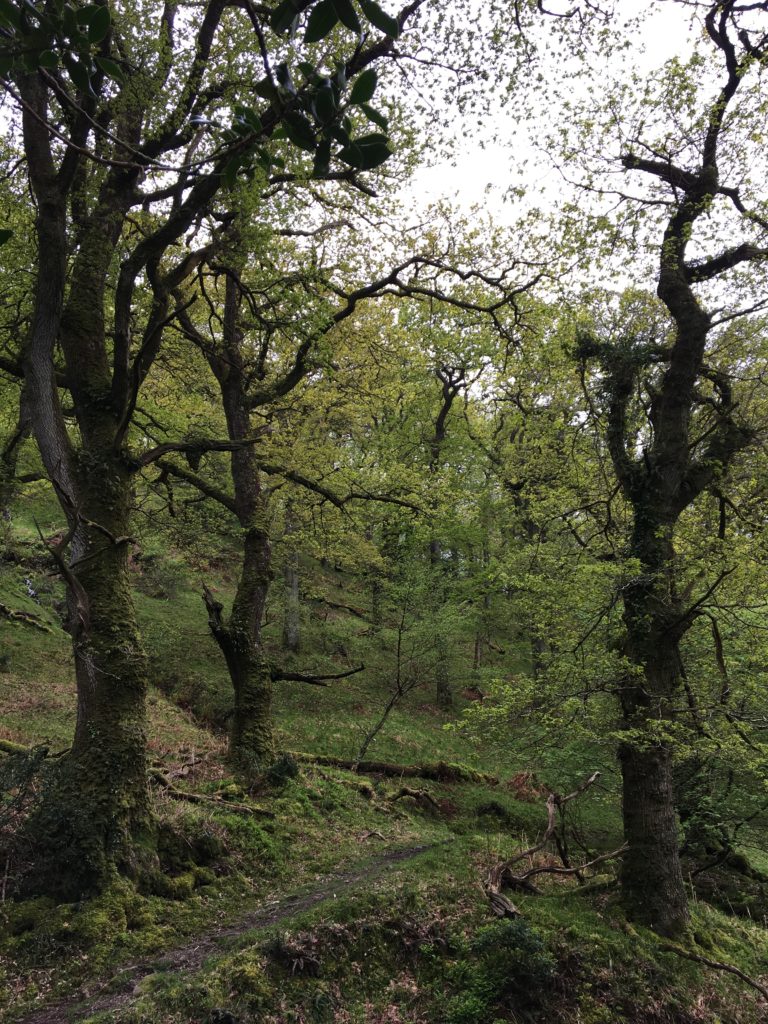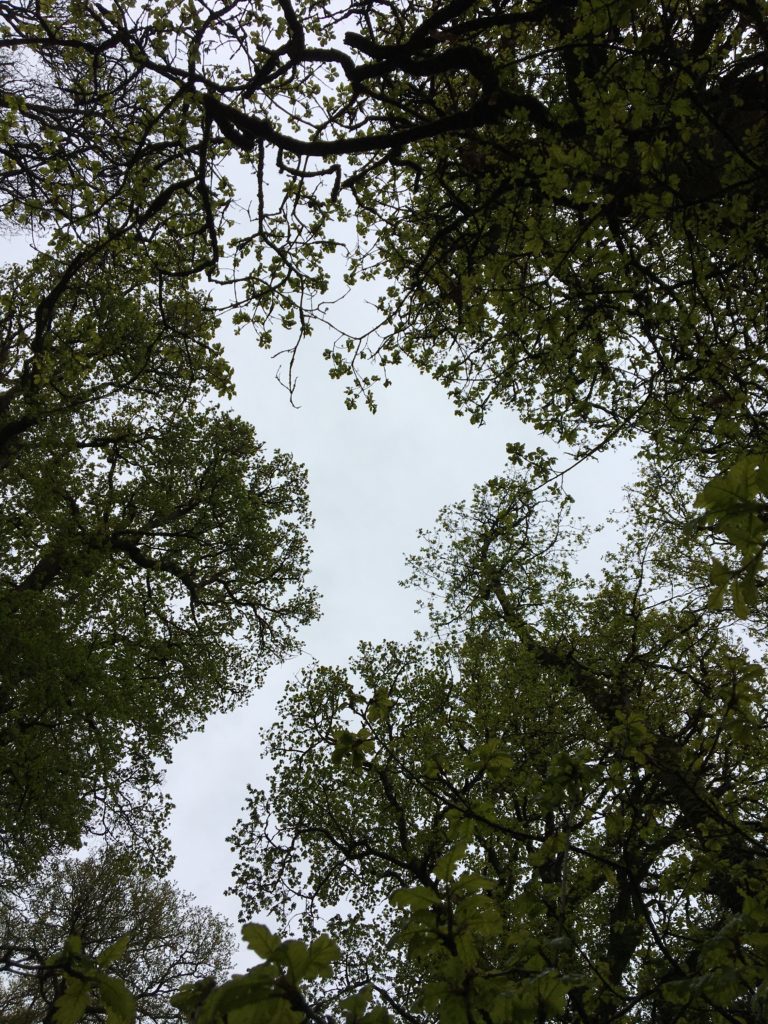Our coopedupee Tim Dee gets his first taste of freedom.

Greenery at Horner Wood, Exmoor
Friday 28th May
It was the greenery that most surprised me though perhaps that won’t surprise anyone else. For ten days I’d made a talisman of the vertical strip of three trees I could see in a gap between the wall of buildings from my London quarantine window – I applied those trees like a nicotine patch or a cucumber treatment for the eyes – but theirs was a lifeless and tamed green, growing under licence in a little park, hemmed in by tarmac and concrete and brick. When I made it to the end, the green I saw on my way west was like a midwife to happiness. Coming out, after ten days in, and heading off, by taxi, bus, car and, at last, on foot, the sensation was of progressively entering deeper and thicker and further into the colour itself. Green is for go and I go-ed or went with it. Having been without it, probably for the longest time ever in my life, it came somehow inside me, as if simply trafficking roadside grass, field greens, new-leaved hedge-trees and finally a wild oak wood in its slow walk up a moorland valley, was to be transfused with all the quickening pigments of chlorophyll.
Greens – they’re good for you! I’m writing this in a supermarket carpark in Minehead. On my lap is one of four bunches of watercress I’ve just bought. I couldn’t hold off eating. Watercress is rare in South Africa where I’ve been living for two years, while in London the quarantine hotel meals never ran to any fresh leaf. The Very Hungry Caterpillar man has just died too and my little boy, Adam, back in Cape Town, loves that book. Today, watercress felt essential: an oasis, life supporting.
Emotional support in my confinement I tried to get from the birds even more than from the scrap of park green. I wore my binoculars often in my room. The trouble was that I didn’t look out on much that wasn’t a building. I never saw any bird in the measly park. Overall, I clocked only six species in ten days of peering for hours from my window or when staring skyward on my walking and jogging circuits during my permitted twenty-minute daily exercise. The sixth species, a swift, I saw on my second day; after that, eight days went by with no addition to my list. I complained about it to my guards (I took my bins with me on some walks) as if birds might be on some internationally agreed human rights accord. Escorted back to my bedroom hutch, I searched online for comforting bird-comforting stories from elsewhere, like the woman offloaded from a flight in the US because her emotional support peacock was too disruptive. Still hungry, I watched clips from The Birdman of Alcatraz.
There was not one sparrow to be seen from my prison – the Birdman’s gateway bird. My two escapologists from my six are among the best I could imagine. I was lucky in this way.

Horner Wood
On three days, there were a few ever-escaping swifts high in the sky; and, every day but one, there were often one or two peregrines on or around the great grey slab of the Holiday Inn, which blocked my view. The peregrines did good work. I ended up even turning from my window when they were still to be seen, perched on the high roof. I liked the idea of them drilling down the one-thousand yards between us. It reminded me of how it felt in my teenage days when a test or something like that was underway in your classroom, and the teacher walked between the rows of desks to the back of the class and turned, and you could feel them looking over you from behind with all their teacherly disappointment already palpable and prickling up and down your neck.
Sometimes I had to turn from the staring bird because I had birds to talk about via my laptop screen. For my first five captive days I was teaching or trying to teach nature writing and these last five days I have been attending several events in the London Review of Books festival called The Birds. One day from my bird-hide on the fifth-floor, I spoke to Zakiya McKenzie, Paul Theroux and Jon Day about the birds in their lives: Jon’s loft of racing pigeons, the Bristol back-garden birds (including cloacal-pecking dunnocks) that lockdown led Zakiya to attend to for the first time, and the gaggle of geese that Paul has long kept on the grass at his home in Hawaii. All evinced strong feelings for their birds: until she deduced what was going on, Zakiya thought she’d like to be attended to as a female dunnock is; Paul admitted mourning Willy, a favoured white Embden goose, more than his one-hundred-and-four-year-old mother; Jon singled out J.A. Baker’s The Peregrine for praise even though its subject – dubbed Percy by pigeon fanciers in an attempt, presumably, to belittle its power – is known to be slayer-in-chief of flights or kits of racing birds.
We weren’t really talking about birdwatching, but I suggested that the three were true birders. Verbing the word gives it a transgenic suggestiveness. To say we bird sounds like a kind of becoming.
The peregrines on the Holiday Inn helped me with that too. Mostly they got me ready for my going by being so obviously in charge of themselves, the captives of nothing but their own lives. Eventually, I was able to take a bus west towards my aged mother to try to live the same way for a few weeks. Any prisoner will be marked however by their captivity, I am sure, and my handful of caged days will colour all sorts for yet some time. That is why the green seemed such a loud announcement – it was life outside.

The way through the woods at Horner
My first red kite in fourteenth months was at Datchet. By Maidenhead I had added wood pigeon, magpie and roe deer to my new-life list. There were wild cherries in blossom still on the motorway verges and some of the may hawthorn had not yet gone over. All this ordinariness felt ravishing, like a tonic. There was a sign, which I have always liked, which warns of deer for the next (very precise) forty-three miles. On this journey, I loved it. At Reading, starlings and one black-headed gull: I knew them all already, yet every one looked new made to my eyes. Steam off some bluebells near Chieveley, candles on a conker tree, ashes frilling. I didn’t want to but I fell asleep around Swindon then woke to see rooks feeding their fledglings in a close-cropped grass field; my first buzzard followed, clenched like a fist on a fence post. Nothing for the notebook – everything for the soul.
At Nether Stowey a swallow flashed across the road: the first I have seen in the northern hemisphere this year. It looked supremely fit, though it might have come on its six inches of wings from Cape Town, where I’ve come from too (hence my caging, quarantine, testing etc.). At Minehead, talking to my mother by talking about the birds above her garden, I tried to show her the jockeying sickles of black swifts climbing the sky and screaming it down, and then the homely chatter and roof-attendance of the pair of house martins – benison in a bird – nesting on a neighbour’s house. Then I went out to my own personal heaven: the oak woods at Horner and their special birds (those I began this diary by promising not to go on about).
The weather has been harsh: grey, wet, cold. The season must be part, at least, held up. When in my cage, I was glad while it rained because it allowed me to think the spring might wait for me to get out. But what if the bad weather has done for my loved ones?
There were still tight-curled croziers of bracken on the floor of the wood at Horner. In mid-April some years I have seen the oaks at the same leaf stage – yellowish, slight, unfilled – as they were today at the end of May. I took my habitual route. There were more black slugs on the Boys Path than miraculous dryads in the oaks. The streams coming off Dunkery were fast and full; wet pillows of moss below the trees were spongily alive and pulsed in the sub-marine rain-light. There were spring birds, but for a long time – increasingly anxious-making – they were not my required species. Were they finished with breeding already, or were they dead? Garden warblers gurgled, chiffchaffs and willow warblers sang from the same trees as they are not supposed to do, a pair of spotted flycatchers snapped after insects on flight sallies from a dotterel oak, a cuckoo called seemingly within the rain, putting an echo into the weather. I’d been walking and listening and looking (though I hardly saw a single bird) for ninety minutes when, in my favourite place within my favourite place, in a steep-sloped, stream-cut, and fabulously green glade, with tall straight living oaks and at their feet many fallen, slow dying, mossed giants, from somewhere sang a male redstart. I couldn’t see it, but in an instant felt born again. A dozen slugs further down the path, I caught, in my less than expert ears, a smidgen of wood warbler. I didn’t see it and the distant trilling descant might have been a more than usually poetic wren; my heart smiled, nonetheless. Next, a pied flycatcher, no doubt about its song or my i.d., though I couldn’t see it either. But there was an answering male too, and then another, and a little chain of their metalworking song was there, slung through the trees. The last song moved, and I saw it, a black and white flutter near a hole in an oak, a female came close too, watching everything, and the male opened its beak and shuffled its wings and danced for her.
That would do. I was free. The birds had set me so. And, like them too, I had come home.

Green thoughts in a green shade – Horner
*
Tim Dee’s ‘Greenery’ is now out in paperback